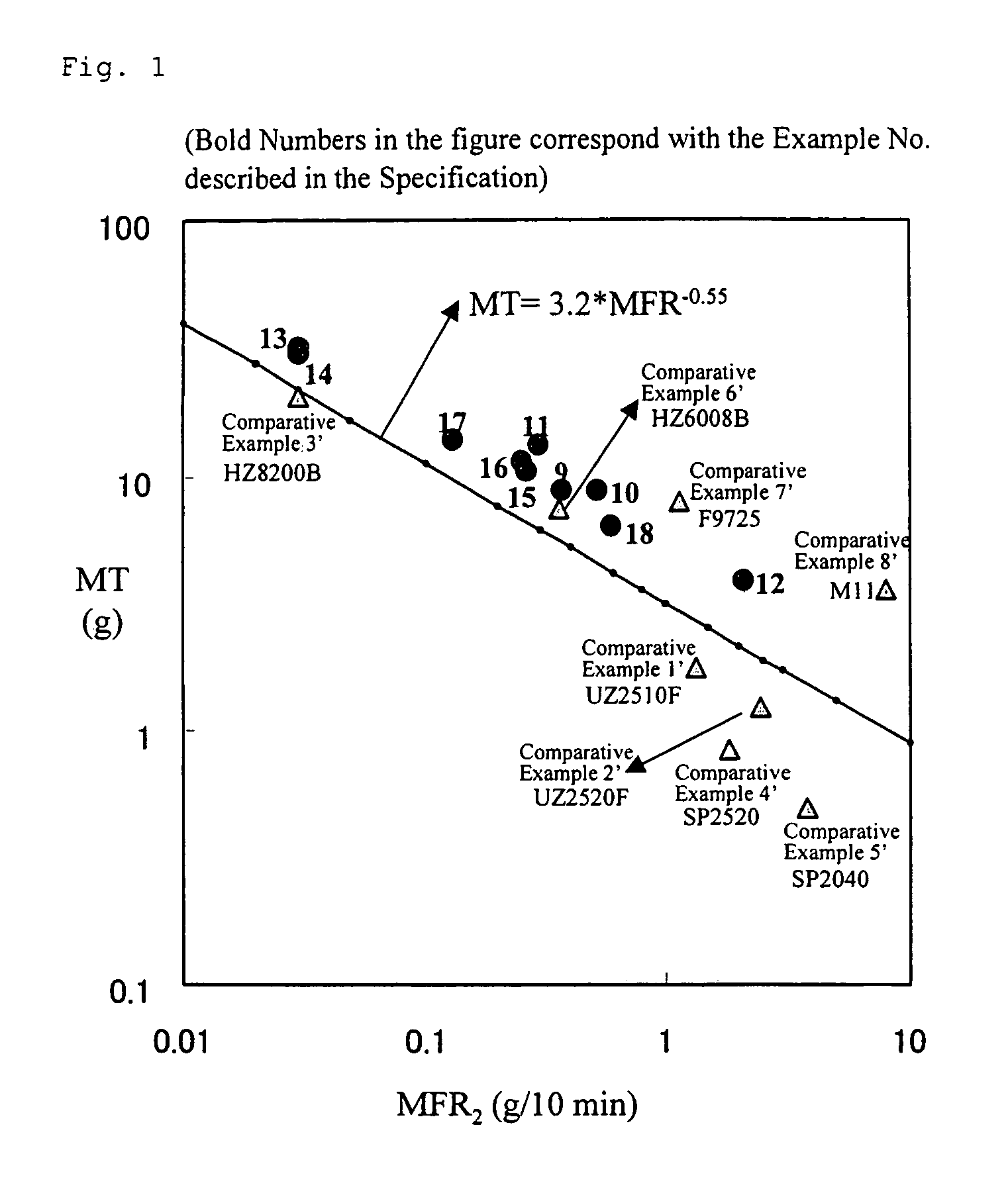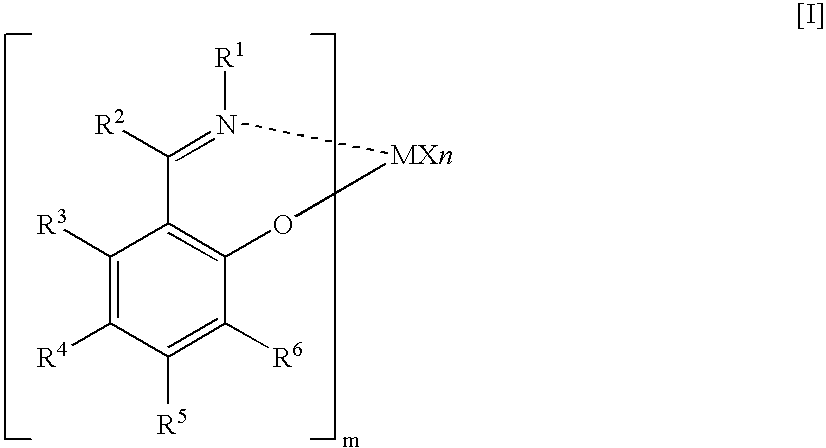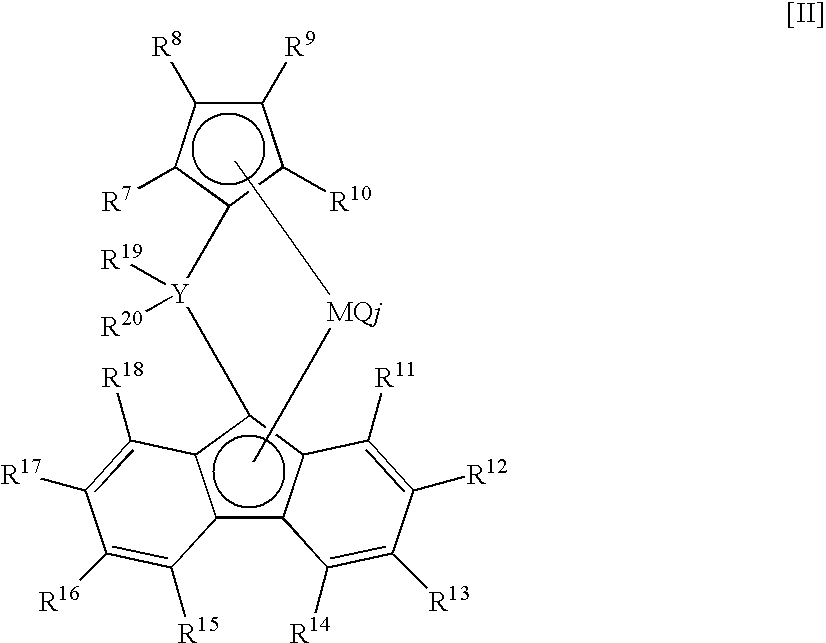Ethylene polymer
a technology of ethylene and polyethylene, applied in the field of new ethylene-based polymers, can solve the problems of high fluidization, inability to meet the mt and swell ratio, and limit the physical properties which can be achieved
- Summary
- Abstract
- Description
- Claims
- Application Information
AI Technical Summary
Benefits of technology
Problems solved by technology
Method used
Image
Examples
example 1
Preparation of solid catalyst component (F)
[0184]71.05 ml toluene was introduced into a 300-ml glass flask flushed previously with nitrogen, and then charged under stirring with 8.95 ml slurry of the solid component (E) in toluene (1.06 g in terms of solids content) prepared above. Then, 20.0 ml solution containing 0.0165 mmol compound (1) below and 0.0135 mmol compound (2) below was added there to dropwise over 15 minutes, and the mixture was reacted at room temperature for 1 hour. Thereafter, the supernatant was removed by decantation, and the remaining solids were washed 3 times with heptane, followed by adding 100 ml heptane, to prepare slurry of the solid catalyst component (F) in heptane. A part of the resulting slurry of the solid catalyst component (F) in heptane was collected to examine its concentration, indicating that the Zr concentration was 0.000201 mmol / ml, and the A1 concentration was 0.0615 mmol / ml.
[0185]
[0186]500 ml heptane was introduced into an SU...
example 2
Preparation of Solid Catalyst Component (G)
[0188]35.52 ml toluene was introduced into a 300-ml glass flask flushed previously with nitrogen, and then charged under stirring with 4.48 ml slurry of the solid component (E) in toluene (0.533 g in terms of solids content) prepared above. Then, 10.0 ml solution containing 0.0128 mmol compound (1) used in Example 1 above and 0.0022 mmol compound (3) below was added thereto dropwise over 15 minutes, and the mixture was reacted at room temperature for 1 hour. Thereafter, the supernatant was removed by decantation, and the remaining solids were washed 3 times with heptane, followed by adding 100 ml heptane, to prepare slurry of the solid catalyst component (G) in heptane. A part of the resulting slurry of the solid catalyst component (G) in heptane was collected to examine its concentration, indicating that the Zr concentration was 0.000105 mmol / ml, and the A1 concentration was 0.0328 mmol / ml.
[0189]
[0190]500 ml n-heptane was i...
example 3
Preparation of Solid Catalyst Component (H)
[0192]35.52 ml toluene was introduced into a 300-ml glass flask flushed previously with nitrogen, and then charged under stirring with 4.48 ml slurry of the solid component (E) in toluene (0.533 g in terms of solids content) prepared above. Then, 10.0 ml solution containing 0.0116 mmol compound (4) below and 0.0034. mmol compound (3) used in Example 2 above was added thereto dropwise over 15 minutes, and the mixture was reacted at room temperature for 1 hour. Thereafter, the supernatant was removed by decantation, and the remaining solids were washed 3 times with heptane, followed by adding 100 ml heptane, to prepare slurry of the solid catalyst component (H) in heptane. A part of the resulting slurry of the solid catalyst component (H) in heptane was collected to examine its concentration, indicating that the Zr concentration was 0.000110 mmol / ml, and the A1 concentration was 0.0280 mmol / ml.
[0193]
[0194]500 ml heptane was in...
PUM
| Property | Measurement | Unit |
|---|---|---|
| density | aaaaa | aaaaa |
| density | aaaaa | aaaaa |
| density | aaaaa | aaaaa |
Abstract
Description
Claims
Application Information
 Login to View More
Login to View More - R&D
- Intellectual Property
- Life Sciences
- Materials
- Tech Scout
- Unparalleled Data Quality
- Higher Quality Content
- 60% Fewer Hallucinations
Browse by: Latest US Patents, China's latest patents, Technical Efficacy Thesaurus, Application Domain, Technology Topic, Popular Technical Reports.
© 2025 PatSnap. All rights reserved.Legal|Privacy policy|Modern Slavery Act Transparency Statement|Sitemap|About US| Contact US: help@patsnap.com



